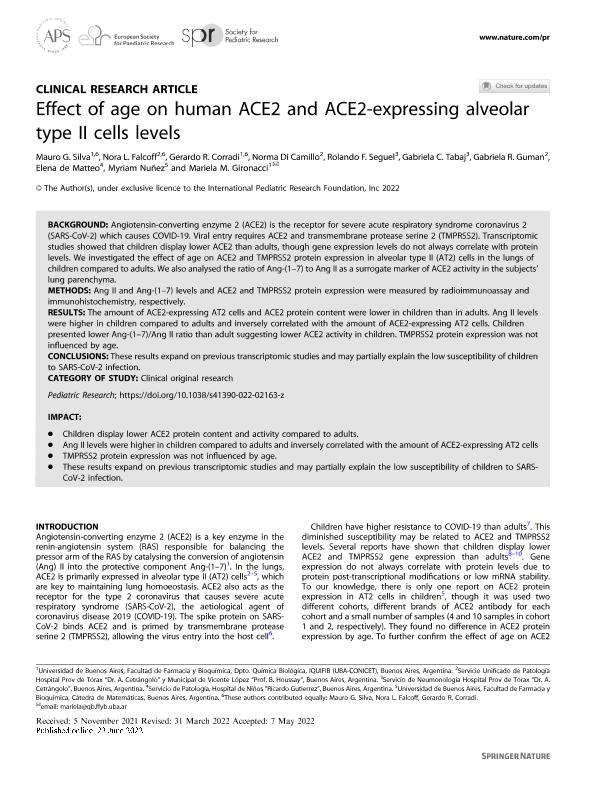Mostrar el registro sencillo del ítem
dc.contributor.author
Silva, Mauro Gastón

dc.contributor.author
Falcoff, Nora L.
dc.contributor.author
Corradi, Gerardo Raul

dc.contributor.author
Di Camillo, Norma Alicia

dc.contributor.author
Seguel, Rolando F.
dc.contributor.author
Tabaj, Gabriela C.
dc.contributor.author
Guman, Gabriela R.
dc.contributor.author
de Matteo, Elena Noemí

dc.contributor.author
Nuñez, Myriam
dc.contributor.author
Gironacci, Mariela Mercedes

dc.date.available
2023-10-10T17:47:07Z
dc.date.issued
2022-06
dc.identifier.citation
Silva, Mauro Gastón; Falcoff, Nora L.; Corradi, Gerardo Raul; Di Camillo, Norma Alicia; Seguel, Rolando F.; et al.; Effect of age on human ACE2 and ACE2-expressing alveolar type II cells levels; International Pediatric Research Foundation; Pediatric Research; 93; 4; 6-2022; 948-952
dc.identifier.issn
0031-3998
dc.identifier.uri
http://hdl.handle.net/11336/214748
dc.description.abstract
Background: Angiotensin-converting enzyme 2 (ACE2) is the receptor for severe acute respiratory syndrome coronavirus 2 (SARS-CoV-2) which causes COVID-19. Viral entry requires ACE2 and transmembrane protease serine 2 (TMPRSS2). Transcriptomic studies showed that children display lower ACE2 than adults, though gene expression levels do not always correlate with protein levels. We investigated the effect of age on ACE2 and TMPRSS2 protein expression in alveolar type II (AT2) cells in the lungs of children compared to adults. We also analysed the ratio of Ang-(1–7) to Ang II as a surrogate marker of ACE2 activity in the subjects’ lung parenchyma. Methods: Ang II and Ang-(1–7) levels and ACE2 and TMPRSS2 protein expression were measured by radioimmunoassay and immunohistochemistry, respectively. Results: The amount of ACE2-expressing AT2 cells and ACE2 protein content were lower in children than in adults. Ang II levels were higher in children compared to adults and inversely correlated with the amount of ACE2-expressing AT2 cells. Children presented lower Ang-(1–7)/Ang II ratio than adult suggesting lower ACE2 activity in children. TMPRSS2 protein expression was not influenced by age. Conclusions: These results expand on previous transcriptomic studies and may partially explain the low susceptibility of children to SARS-CoV-2 infection. Category of study: Clinical original research Impact: Children display lower ACE2 protein content and activity compared to adults.Ang II levels were higher in children compared to adults and inversely correlated with the amount of ACE2-expressing AT2 cellsTMPRSS2 protein expression was not influenced by age.These results expand on previous transcriptomic studies and may partially explain the low susceptibility of children to SARS-CoV-2 infection.
dc.format
application/pdf
dc.language.iso
eng
dc.publisher
International Pediatric Research Foundation

dc.rights
info:eu-repo/semantics/openAccess
dc.rights.uri
https://creativecommons.org/licenses/by-nc-sa/2.5/ar/
dc.subject
Angiotensin-converting enzyme 2 (ACE2)
dc.subject
Effect of age
dc.subject
SARS-CoV-2
dc.subject
COVID-19
dc.subject.classification
Bioquímica y Biología Molecular

dc.subject.classification
Ciencias Biológicas

dc.subject.classification
CIENCIAS NATURALES Y EXACTAS

dc.title
Effect of age on human ACE2 and ACE2-expressing alveolar type II cells levels
dc.type
info:eu-repo/semantics/article
dc.type
info:ar-repo/semantics/artículo
dc.type
info:eu-repo/semantics/publishedVersion
dc.date.updated
2023-07-07T22:56:32Z
dc.journal.volume
93
dc.journal.number
4
dc.journal.pagination
948-952
dc.journal.pais
Estados Unidos

dc.description.fil
Fil: Silva, Mauro Gastón. Consejo Nacional de Investigaciones Científicas y Técnicas. Oficina de Coordinación Administrativa Houssay. Instituto de Química y Físico-Química Biológicas "Prof. Alejandro C. Paladini". Universidad de Buenos Aires. Facultad de Farmacia y Bioquímica. Instituto de Química y Físico-Química Biológicas; Argentina
dc.description.fil
Fil: Falcoff, Nora L.. Provincia de Buenos Aires. Ministerio de Salud. Hospital "Dr. Antonio A. Cetrángolo"; Argentina
dc.description.fil
Fil: Corradi, Gerardo Raul. Consejo Nacional de Investigaciones Científicas y Técnicas. Oficina de Coordinación Administrativa Houssay. Instituto de Química y Físico-Química Biológicas "Prof. Alejandro C. Paladini". Universidad de Buenos Aires. Facultad de Farmacia y Bioquímica. Instituto de Química y Físico-Química Biológicas; Argentina
dc.description.fil
Fil: Di Camillo, Norma Alicia. Provincia de Buenos Aires. Ministerio de Salud. Hospital "Dr. Antonio A. Cetrángolo"; Argentina
dc.description.fil
Fil: Seguel, Rolando F.. Provincia de Buenos Aires. Ministerio de Salud. Hospital "Dr. Antonio A. Cetrángolo"; Argentina
dc.description.fil
Fil: Tabaj, Gabriela C.. Provincia de Buenos Aires. Ministerio de Salud. Hospital "Dr. Antonio A. Cetrángolo"; Argentina
dc.description.fil
Fil: Guman, Gabriela R.. Provincia de Buenos Aires. Ministerio de Salud. Hospital "Dr. Antonio A. Cetrángolo"; Argentina
dc.description.fil
Fil: de Matteo, Elena Noemí. Gobierno de la Ciudad de Buenos Aires. Hospital General de Niños "Ricardo Gutiérrez"; Argentina. Centro de Estudios Históricos "Profesor Carlos S. A. Segreti". Instituto de Estudios Históricos - Consejo Nacional de Investigaciones Científicas y Técnicas. Centro Científico Tecnológico Conicet - Córdoba. Instituto de Estudios Históricos; Argentina
dc.description.fil
Fil: Nuñez, Myriam. Universidad de Buenos Aires; Argentina
dc.description.fil
Fil: Gironacci, Mariela Mercedes. Consejo Nacional de Investigaciones Científicas y Técnicas. Oficina de Coordinación Administrativa Houssay. Instituto de Química y Físico-Química Biológicas "Prof. Alejandro C. Paladini". Universidad de Buenos Aires. Facultad de Farmacia y Bioquímica. Instituto de Química y Físico-Química Biológicas; Argentina
dc.journal.title
Pediatric Research

dc.relation.alternativeid
info:eu-repo/semantics/altIdentifier/doi/http://dx.doi.org/10.1038/s41390-022-02163-z
Archivos asociados
